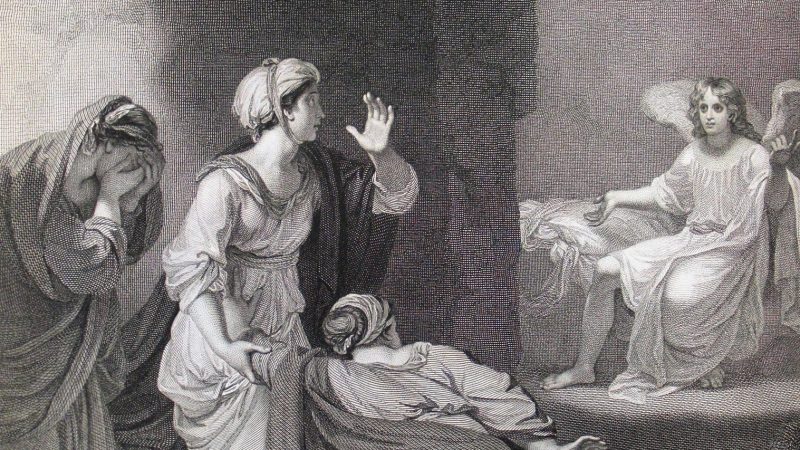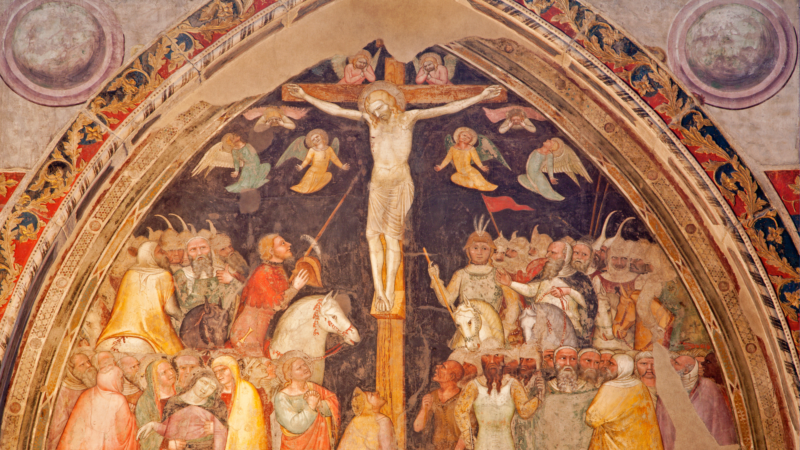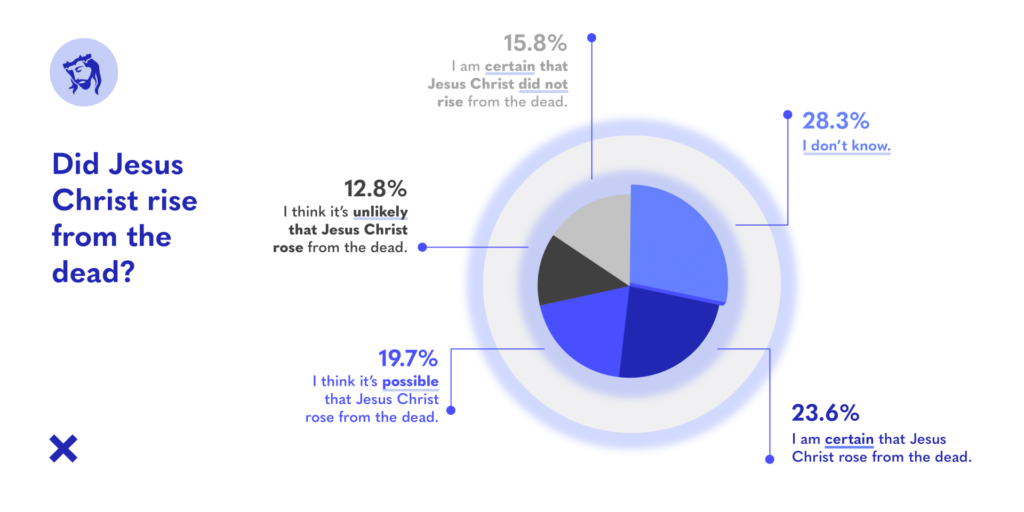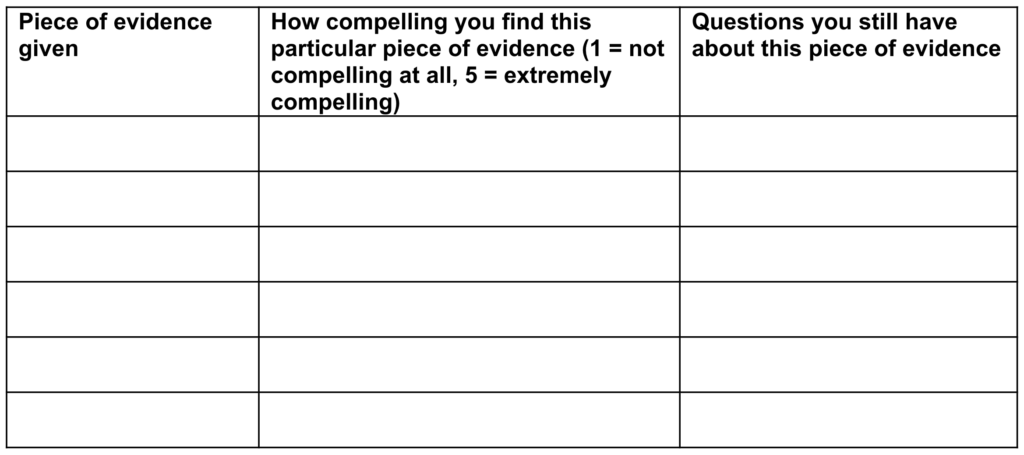Youth Resource
Is there evidence that Jesus’ resurrection actually took place?
There are good reasons to trust that Jesus’ resurrection was an historical event, and therefore it is worth considering whether this might have implications for life today.
Videos
-
An historian examines the resurrection
This extract from the Life of Jesus documentary considers the evidence for the resurrection.
Transcript
JOHN DICKSON: The garden tomb is a popular site for pilgrims wanting to see where Jesus may have been buried. What motivates a person to visit a place like this is not so much firm proof, as a personal conviction based on a whole range of things. I mean, evidence will play a part for many of these pilgrims, but so will the deeper philosophical questions such as ‘Is there a god?’, and ‘Would God do such a thing as raise someone from the dead?’ Historians though, ask much simpler questions. How early is the evidence for claims about Jesus’ resurrection? Was there an empty tomb in the first place? And who were the eyewitnesses?
This is one of the many ancient family tombs cut into the local limestone here in Jerusalem. This one was probably emptied by grave-robbers centuries ago. Most scholars agree that Jesus’ tomb was likewise empty shortly after his burial. Now this is partly because we have several independent reports from the first century that mention Jesus’ empty tomb. But it’s also because we know of an early rumour, spread about by the Jerusalem leadership, that the disciples of Jesus actually stole his body from the tomb. This at least tells us that even the early critics of Christianity conceded there was an empty tomb. They just disputed how it got that way.
But an empty tomb can be explained in a number of ways. In the end, what inspired the early Christians to believe that Jesus really was alive again was not an empty tomb but the claim of his disciples that they had seen him with their own eyes.
ACTOR (1 CORINTHIANS 15:3-8): For what I received I passed onto you as of first importance: that Christ died for our sins according to the Scriptures, that he was buried, that he was raised on the third day according to the Scriptures, and that he appeared to Peter, and then to the twelve. After that he appeared to more than 500 of the brothers and sisters at the same time, most of whom are still living, though some have fallen asleep. Then he appeared to James, then to all the apostles, and last of all he appeared to me also, as to one abnormally born.
JOHN DICKSON: The incredibly early date of this summary of Christian teaching rules out any suggestion that the resurrection story was part of a slowly developing legend. No scholar thinks that. It’s just an unavoidable fact of history that from the very beginning, people were claiming to have seen Jesus, alive from the dead.
Paul’s letter mentions six separate individuals or groups who saw the risen Jesus. Many of these ended up dying for their testimony. But there’s another group of witnesses that has to be taken just as seriously: Jesus’ female disciples.
All four gospels have women as the first witnesses of the resurrection. Now, modern scholars find this remarkable because – and I hate to say it – the testimony of women in this period was not highly valued. The first century Jewish historian Josephus wrote: “From women, let no evidence be accepted, because of the levity and temerity of their sex.” And a statue from ancient Palestine declares: “The law governing an oath of testimony applies to men and not to women; to those who are suitable to bear witness and not to those who are unsuitable.”
If you were writing up a story about a resurrection and you wanted first century people to believe it, you would not include women as the first witnesses unless, somewhat embarrassingly, that really was the case.
There is no hard proof for the resurrection of Jesus. But we do have just the sort of evidence a resurrection would leave behind: an empty tomb, and the testimony of numerous eyewitnesses (many of whom died for their claim).
This is why historians take the resurrection story far more seriously than many of us realise. They all agree that something very strange happened that first Easter. As one scholar memorably put it, “There is a resurrection-shaped dent in the historical record, and it’s quite a puzzle working out how it got there.”
close -
The criterion of embarrassment
Darrell Bock on how embarrassing parts of the resurrection story suggest that it wasn’t just made up.
Transcript
DARRELL BOCK: Well embarrassment is a really important criterion for this event. Because remember that the alternative claim is that this event was made-up. I was just speaking to the leaders of the financial community here in Sydney earlier today and I was saying: Imagine you’re in a PR room, and you’re trying to sell a difficult idea – a dead Messiah who’s come back to life. So you’ve got two things that are difficult about that: the fact that the Messiah died, which they weren’t anticipating, they were expecting a victorious Messiah, and the fact that he was raised from the dead, which wasn’t a popular idea in Graeco-Roman or some parts of Jewish culture. And so you’re going to sell this difficult idea, that has two levels of difficulty to it, it’s kind of a big dive on the 2.9 difficulty stage on the 3 scale, and the way you’re going to do it is you’re going to present as your first witnesses women. Not what you’ve got to understand about the ancient culture is the women couldn’t be witnesses in a court of law unless it was a sexual abuse case. They didn’t count as witnesses. So here you are selling this difficult idea, that the culture doesn’t believe, you get to make up the story, and you make up the story by having women at the start who don’t count culturally as witnesses – you’re not going to make up the story that way; that’s the criterion of embarrassment. The women are in the story because the women were in the original story, and that’s the only way for explaining why they were there.
There’s a second example of embarrassment with regards to the resurrection, and that’s when the women come to report that the angel has told them that the tomb is empty and that Jesus is alive and that he’s been raised, the apostles respond by viewing the women’s response as an idle tale; they don’t believe it. This is embarrassment again. Here are your leaders, who are selling this difficult message as you will, they’re presenting it, and you’re undercutting their credibility because they react to the women by saying, “Oh, it was an idle tale” – that’s what Luke tells us. The way I like to say this is that what the apostles said to the women is, “You’re suffering from post-crucifixion syndrome. You know, it’s been a really tough few days and you’re over-reacting, your grief has gotten to you.” So, they didn’t believe it. Now again, you wouldn’t make up the story that way unless it happened, because it impacts your view of the credibility of the witnesses who are presenting the material. So it’s in the story because it was in the story. That’s another example of the criterion of embarrassment, and those are two good reasons why we don’t think the resurrection was made up.
close -
Miracle Stories: The Resurrection of Jesus
Craig Keener discusses the historical evidence for the resurrection and its implications for life today.
Transcript
SIMON SMART: What can historians say about the biggest miracle of all, the resurrection of Jesus?
CRAIG KEENER: Some people want to bracket out the question of the supernatural from historiography, and if you define historiography in that way, then of course, that’s just a matter of definition, you can do that. But even if you bracket out the question of the cause (whether God did this or not), we’re still left with the data. The data includes the empty tomb, and an early biography of Jesus, and even earlier than that we have a massive amount of evidence for people who claimed to have seen Jesus alive from the dead. And these were people who had everything to lose by claiming that Jesus was still alive from the dead and that this person who had been executed by the authorities was now Lord of creation. That is something that could get you in big trouble.
SIMON SMART: And one final question: what does that resurrection mean today? What difference can it make to life now?
CRAIG KEENER: If Jesus rose from the dead and was transformed to another order of existence, that means that he is not just alive somewhere, but it validates his claim that he is Lord. If we acknowledge that Jesus truly rose from the dead, it’s not just an act of past history; it means that Jesus is still alive, and Jesus still comes to us with his demands on our lives, and he still comes to us with this promise of a new life for us. And there’s hope that this promise of resurrection (which was something to which most of the Jewish people in his day were looking) applies not just to Jesus as the first fruits, but is also a hope that we can look forward to of new life in a new world. And if we truly believe in that hope for the future, we can live as people of that future, in the midst of the present.
close
Articles
-

Is it sane to believe in the resurrection?
Are there good reasons to believe in the resurrection of Jesus?
-

The long weekend that changed the world
Natasha Moore ponders how a series of unlikely events that first Easter weekend led to the birth of the world’s largest religion.
-

Fairies at the bottom of the garden
Natasha Moore asks: is accepting the resurrection of Jesus like believing in fairies at the bottom of the garden?
Engage
- In groups of three, play a game of Two Truths and a Lie. Afterwards, discuss: Was it easy or difficult to tell whether something was true or a lie? What made it easy or difficult?
- Read these two very different quotes.


- Think-Pair-Share your initial reaction to each quote, and one follow-up question you’d like to ask Richard Dawkins and/or Lee Strobel.
- Look at this graphic which shows answers to the question ‘Did Jesus rise from the dead?’ from CPX’s Easter 2021 Survey.

- Do these results surprise you? Why or why not?
- What answer would you give to this question?
Understand & Evaluate
- Watch the three videos (An historian examines the resurrection; The criterion of embarrassment; and Miracle stories: The resurrection of Jesus) and read the articles Is it sane to believe in the resurrection? and The long weekend that changed the world. In small groups, fill out the following table based on the different pieces of evidence given in the CPX content to support the historicity of the resurrection:

- Read Natasha Moore’s article Fairies at the bottom of the garden:
- Do the Take Note Thinking Routine for this article
- Natasha writes: “I believe that Jesus rose from the dead for what I sincerely believe to be historical, evidence-based reasons. But not only for those reasons.” Based on what you have read in Natasha and Greg Clarke’s articles, do you think there are other good reasons to believe in the resurrection (other than historical reasons)?
Bible Focus
- Read 1 Corinthians 15:3-8, 14-20 and answer the following questions:
- Why do you think Paul might have emphasised all the people Jesus appeared to after his resurrection, and mention that most of them were still living at the time of writing?
- Why does Paul say that the Christian faith is “useless” if the resurrection didn’t really happen?
- Does it seem like Paul just wants to believe in the resurrection out of wishful thinking? From this passage, what might we conclude about Paul’s beliefs and what he bases them on?
Apply
- Revisit your answer from Engage Question 3b. Has your answer changed, or stayed the same? What extra piece of evidence would you like to see to strengthen the case for Jesus’ resurrection?
- Imagine you saw one of these quotes from Timothy Keller or Craig Keener on Instagram. Write a comment or create a reel responding to the quote.


- Write a paragraph answering this question: If Jesus did rise from the dead, what difference might that make to life today? (You may want to read additional articles from CPX to inform your answer, such as How do we find joy at a funeral?, Easter promises us that death is not extinction, and Is resurrection the theme of 2022?)
Extend
- Create a PowerPoint or Prezi presentation that weighs up the evidence for and against Jesus’ resurrection, using information discovered from your own research as well as the CPX material.


